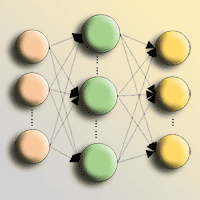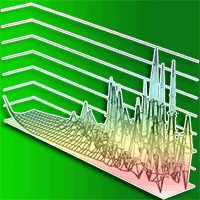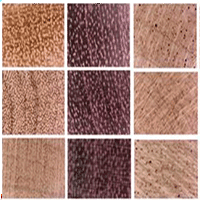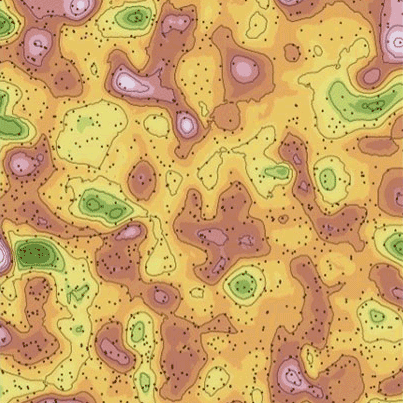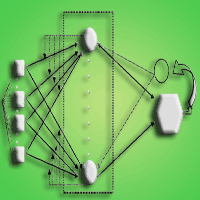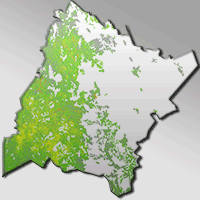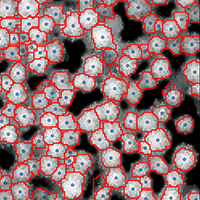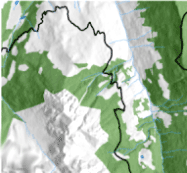In natural forest ecosystems, there is often abundant down dead wood (DDW) due to wind disasters, which greatly changes the size and structure of forests. Accurately determining the DDW volume (DDWV) is crucial for sustaining forest management, predicting the dynamic changes in forest resources and assessing the risks of natural disasters or disturbances. However, existing models cannot accurately express the significant spatial nonstationarity or complexity in their spatial relationships. To this end, we established a geographically weighted deep neural network (GWDNN) model that constructs a spatially weighted neural network (SWNN) through geographic location data and builds a neural network through stand factors and remote sensing factors to improve the interpretability of the spatial model of DDWV. To verify the effectiveness of this method, using 2019 data from Liangshui National Nature Reserve, we compared model fit, predictive ability and residual spatial autocorrelation among the GWDNN model and four other spatial models: an ordinary least squares (OLS) model, a linear mixed model (LMM), a geographically weighted regression (GWR) model and a deep neural network (DNN) model. The experimental results show that the GWDNN model is far superior to the other four models according to various indicators; the coefficient of determination R2, root mean square error (RMSE), mean absolute error (MAE), Moran’s I and Z-statistic values of the GWDNN model were 0.95, 1.05, 0.77, -0.01 and -0.06, respectively. In addition, compared with the other models, the GWDNN model can more accurately depict local spatial variations and details of the DDWV in Liangshui National Nature Reserve.
Keywords
, , , , ,
Citation
Sun Y, Ao Z, Jia W, Chen Y, Xu K (2021). A geographically weighted deep neural network model for research on the spatial distribution of the down dead wood volume in Liangshui National Nature Reserve (China). iForest 14: 353-361. - doi: 10.3832/ifor3705-014
Academic Editor
Maurizio Marchi
Paper history
Received: Nov 27, 2020
Accepted: Jun 03, 2021
First online: Jul 27, 2021
Publication Date: Aug 31, 2021
Publication Time: 1.80 months
© SISEF - The Italian Society of Silviculture and Forest Ecology 2021
Open Access
This article is distributed under the terms of the Creative Commons Attribution-Non Commercial 4.0 International (https://creativecommons.org/licenses/by-nc/4.0/), which permits unrestricted use, distribution, and reproduction in any medium, provided you give appropriate credit to the original author(s) and the source, provide a link to the Creative Commons license, and indicate if changes were made.

Breakdown by View Type
(Waiting for server response...)
Article Usage
Total Article Views: 35837
(from publication date up to now)
Breakdown by View Type
HTML Page Views: 29825
Abstract Page Views: 2723
PDF Downloads: 2760
Citation/Reference Downloads: 5
XML Downloads: 524
Web Metrics
Days since publication: 1599
Overall contacts: 35837
Avg. contacts per week: 156.88
Article Citations
Article citations are based on data periodically collected from the Clarivate Web of Science web site
(last update: Mar 2025)
Total number of cites (since 2021): 12
Average cites per year: 2.40
Publication Metrics
by Dimensions ©
Articles citing this article
List of the papers citing this article based on CrossRef Cited-by.
(1)
Adamec Z, Drápela K (2017)Comparison of parametric and nonparametric methods for modeling height-diameter relationships. iForest 10: 1-8.
CrossRef |
Gscholar
(2)
Anselin L (2001)Spatial effects in econometric practice in environmental and resource economics. American Journal of Agricultural Economics 83: 705-710.
CrossRef |
Gscholar
(3)
Aquino DN, Neto OCR, Moreira MA, Teixeira AS, De Andrade EM (2018)Use of remote sensing to identify areas at risk of degradation in the semi-arid region. Revista Ciencia Agronomica 49: 420-429.
CrossRef |
Gscholar
(4)
Bassett M, Chia EK, Leonard SWJ, Nimmo DG, Holland GJ, Ritchie EG, Clarke MF, Bennett AF (2015)The effects of topographic variation and the fire regime on coarse woody debris: Insights from a large wildfire. Forest Ecology and Management 340: 126-134.
CrossRef |
Gscholar
(5)
Bates D (2005)Fitting linear mixed models in R. R News 5: 27-30.
Online |
Gscholar
(6)
Behrens T, Schmidt K, Viscarra Rossel RA, Gries P, Scholten T, MacMillan RA (2018)Spatial modelling with Euclidean distance fields and machine learning. European Journal of Soil Science 69: 757-770.
CrossRef |
Gscholar
(7)
Boonpook W, Tan Y, Xu B (2021)Deep learning-based multi-feature semantic segmentation in building extraction from images of UAV photogrammetry. International Journal of Remote Sensing 42: 1-19.
CrossRef |
Gscholar
(8)
Brunsdon C, Fotheringham AS, Charlton ME (1996)Geographically weighted regression: a method for exploring spatial nonstationarity. Geographical Analysis 28: 281-298.
CrossRef |
Gscholar
(9)
Chen L, Ren C, Zhang B, Wang Z, Xi Y (2018)Estimation of forest above-ground biomass by geographically weighted regression and machine learning with Sentinel imagery. Forests 9 (10): 582.
CrossRef |
Gscholar
(10)
Choi S, Lee S, Kang Y, Choi DY, Choi J (2020)Use of unmanned aerial vehicle imagery and deep learning UNet to classification upland crop in small scale agricultural land. Journal of the Korean Society of Surveying, Geodesy, Photogrammetry and Cartography 38: 671-679.
Online |
Gscholar
(11)
Chojnacky DC, Heath LS (2002)Estimating down deadwood from FIA forest inventory variables in Maine. Environmental Pollution 116 (7): S25-S30.
CrossRef |
Gscholar
(12)
Costa S, Ibanez L (2005)Can wood storage be profitable? French experience after the windstorms in 1999. Journal of Forest Economics 11: 161-176.
CrossRef |
Gscholar
(13)
Deb D, Singh JP, Deb S, Datta D, Ghosh A, Chaurasia RS (2017)An alternative approach for estimating above ground biomass using Resourcesat-2 satellite data and artificial neural network in Bundelkhand region of India. Environmental Monitoring and Assessment 189 (11): 631.
CrossRef |
Gscholar
(14)
Du M, Noguchi N (2016)Multi-temporal monitoring of wheat growth through correlation analysis of satellite images, unmanned aerial vehicle images with ground variable. IFAC-PapersOnLine 49: 5-9.
CrossRef |
Gscholar
(15)
Du Z, Wang Z, Wu S, Zhang F, Liu R (2020)Geographically neural network weighted regression for the accurate estimation of spatial non-stationarity. International Journal of Geographical Information Science 34: 1353-1377.
CrossRef |
Gscholar
(16)
Fassnacht FE, Hartig F, Latifi H, Berger C, Hernandez J, Corvalan P, Koch B (2014)Importance of sample size, data type and prediction method for remote sensing-based estimations of aboveground forest biomass. Remote Sensing of Environment 154: 102-114.
CrossRef |
Gscholar
(17)
Fotheringham AS, Charlton ME, Brunsdon C (1998)Geographically weighted regression: a natural evolution of the expansion method for spatial data analysis. Environment and Planning A 30: 1905-1927.
CrossRef |
Gscholar
(18)
Green JL, Hastings A, Arzberger P, Ayala FJ, Cottingham KL, Cuddington K, Davis F, Dunne JA, Fortin M-J, Gerber L, Neubert M (2005)Complexity in ecology and conservation: mathematical, statistical, and computational challenges. BioScience 55: 501-510.
CrossRef |
Gscholar
(19)
Hagan JM, Grove SL (1999)Coarse woody debris: humans and nature competing for trees. Journal of Forestry 97: 6-11.
Online |
Gscholar
(20)
Harmon ME, Franklin JF, Swanson FJ, Sollins P, Gregory SV, Lattin JD, Anderson NH, Cline SP, Aumen NG, Sedell JR, Lienkaemper GW, Cromack Jr K, Cummins KW (1986)Ecology of coarse woody debris in temperate ecosystems. Advances in Ecological Research 15: 133-302.
CrossRef |
Gscholar
(21)
Irfan M, Koj A, Thomas H, Sedighi M (2016)Geographical General Regression Neural Network (GGRNN) tool for geographically weighted regression analysis. In: Proceedings of the 8th International Conference on “Advanced Geographic Information Systems, Applications, and Services”. Venice (Italy), 24-28 April 2016. GEOProcessing 2016, pp. 154-159.
Online |
Gscholar
(22)
Jenkins MA, Webster CR, Parker GR, Spetich MA (2004)Coarse woody debris in managed central hardwood forests of Indiana, USA. Forest Science 50: 781-792.
Online |
Gscholar
(23)
Ketkar N (2017)Introduction to Keras. In: “Deep Learning with Python: A Hands-on Introduction” (N Ketkar ed). Apress, Berkeley, CA, USA, pp. 15-30.
CrossRef |
Gscholar
(24)
Kinnucan HW (2016)Timber price dynamics after a natural disaster: hurricane Hugo revisited. Journal of Forest Economics 25: 115-129.
CrossRef |
Gscholar
(25)
Klobučar D (2010)Using geostatistics in forest management. Sumarski List 134: 249-259.
Gscholar
(26)
Lavoie S, Ruel J-C, Bergeron Y, Harvey BD (2012)Windthrow after group and dispersed tree retention in eastern Canada. Forest Ecology and Management 269: 158-167.
CrossRef |
Gscholar
(27)
Lecun Y, Bengio Y, Hinton G (2015)Deep learning. Nature 521: 436-444.
CrossRef |
Gscholar
(28)
Li H, Calder CA, Cressie N (2007)Beyond Moran’s I: testing for spatial dependence based on the spatial autoregressive model. Geographical Analysis 39: 357-375.
CrossRef |
Gscholar
(29)
Li J, Jin M, Li H (2019)Exploring spatial influence of remotely sensed PM2.5 concentration using a developed deep convolutional neural network model. International Journal of Environmental Research and Public Health 16: 454.
CrossRef |
Gscholar
(30)
Liu C, Zhang L, Li F, Jin X (2014)Spatial modeling of the carbon stock of forest trees in Heilongjiang Province, China. Journal of Forestry Research 25: 269-280.
CrossRef |
Gscholar
(31)
Lu J, Zhang L (2011)Modeling and prediction of tree height-diameter relationships using spatial autoregressive models. Forest Science 57: 252-264.
CrossRef |
Gscholar
(32)
Mennis J (2006)Mapping the results of geographically weighted regression. Cartographic Journal 43: 171-179.
CrossRef |
Gscholar
(33)
Miles J (2005)Tolerance and variance inflation factor. Encyclopedia of Statistics in Behavioral Science, North Yorkshire, UK, pp. 1-2.
Gscholar
(34)
Mohammadinia A, Saeidian B, Pradhan B, Ghaemi Z (2019)Prediction mapping of human leptospirosis using ANN, GWR, SVM and GLM approaches. BMC Infectious Diseases 19 (1): 736.
CrossRef |
Gscholar
(35)
Pang Y, Li Z, Ju H, Lu H, Jia W, Si L, Guo Y, Liu Q, Li S, Liu L, Xie B, Tan B, Dian Y (2016)LiCHy: the CAF’s LiDAR, CCD and hyperspectral integrated airborne observation system. Remote Sensing 8 (5): 398.
CrossRef |
Gscholar
(36)
Pfeil EK, Casacchia N, Kerns GJ, Diggins TP (2007)Distribution, composition, and orientation of down deadwood in riparian old-growth woodlands of Zoar Valley Canyon, western New York State, USA. Forest Ecology and Management 239: 159-168.
CrossRef |
Gscholar
(37)
Polo JA, Hallgren SW, Leslie DM (2013)Effect of long-term understory prescribed burning on standing and down dead woody material in dry upland oak forests. Forest Ecology and Management 291: 128-135.
CrossRef |
Gscholar
(38)
Qi YJ, Zhang YC, Wang K, He SQ, Tan W (2020)Application of spatial regression models for forest biomass estimation in Guizhou Province, Southwest China. Applied Ecology and Environmental Research 18: 7215-7232.
CrossRef |
Gscholar
(39)
Quirós-Segovia M, Condés-Ruiz S, Drápela K (2016)Comparison of height-diameter models based on geographically weighted regressions and linear mixed modelling applied to large scale forest inventory data. Forest Systems 25: 76-86.
Online |
Gscholar
(40)
Schmidhuber J (2015)Deep learning in neural networks: an overview. Neural Networks 61: 85-117.
CrossRef |
Gscholar
(41)
Spetich MA, Shifley SR, Parker GR (1999)Regional distribution and dynamics of coarse woody debris in midwestern old-growth forests. Forest Science 45: 302-313.
Online |
Gscholar
(42)
Subedi N, Zhang L, Zhen Z (2018)Bayesian geographically weighted regression and its application for local modeling of relationships between tree variables. iForest 11: 542-552.
CrossRef |
Gscholar
(43)
Sun J, Xu F, Cervone G, Gervais M, Wauthier C, Salvador M (2021)Automatic atmospheric correction for shortwave hyperspectral remote sensing data using a time-dependent deep neural network. ISPRS Journal of Photogrammetry and Remote Sensing 174: 117-131.
CrossRef |
Gscholar
(44)
Tiefelsdorf M (2002)The saddlepoint approximation of Moran’s I’s and local Moran’s I’s reference distributions and their numerical evaluation. Geographical Analysis 34: 187-206.
CrossRef |
Gscholar
(45)
Tiefelsdorf M, Boots B (1995)The exact distribution of Moran’s I. Environment and Planning A 27: 985-999.
CrossRef |
Gscholar
(46)
Wei Q, Zhang L, Duan W, Zhen Z (2019)Global and geographically and temporally weighted regression models for modeling PM2.5 in Heilongjiang, China from 2015 to 2018. International Journal of Environmental Research and Public Health 16: 5107.
CrossRef |
Gscholar
(47)
Wu S, Du Z, Wang Y, Lin T, Zhang F, Liu R (2020)Modeling spatially anisotropic nonstationary processes in coastal environments based on a directional geographically neural network weighted regression. Science of the Total Environment 709: 136097.
CrossRef |
Gscholar
(48)
Wu S, Wang Z, Du Z, Huang B, Zhang F, Liu R (2021)Geographically and temporally neural network weighted regression for modeling spatiotemporal non-stationary relationships. International Journal of Geographical Information Science 35: 582-608.
CrossRef |
Gscholar
(49)
Zhang L, Gove JH (2005)Spatial assessment of model errors from four regression techniques. Forest Science 51: 334-346.
Online |
Gscholar
(50)
Zhen Z, Li F, Liu Z, Liu C, Zhao Y, Ma Z, Zhang L (2013)Geographically local modeling of occurrence, count, and volume of downwood in Northeast China. Applied Geography 37: 114-126.
CrossRef |
Gscholar
